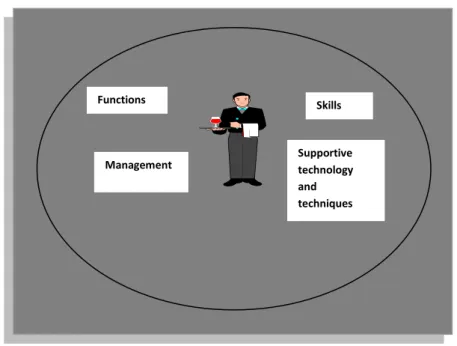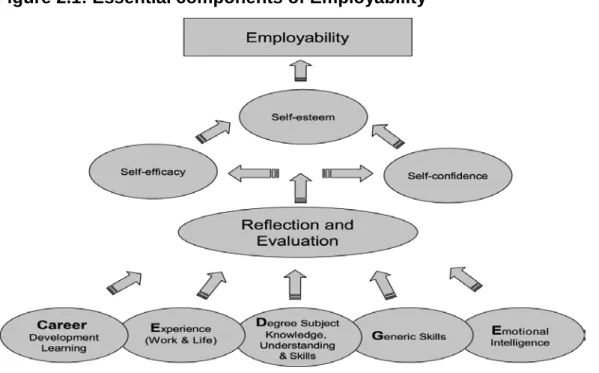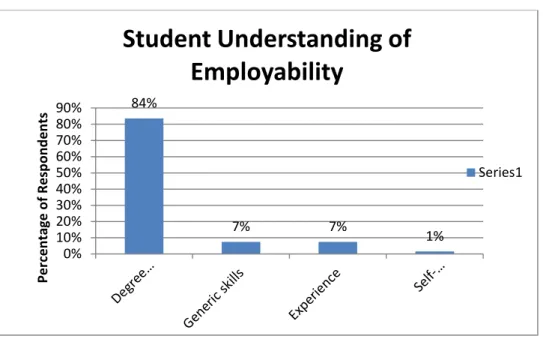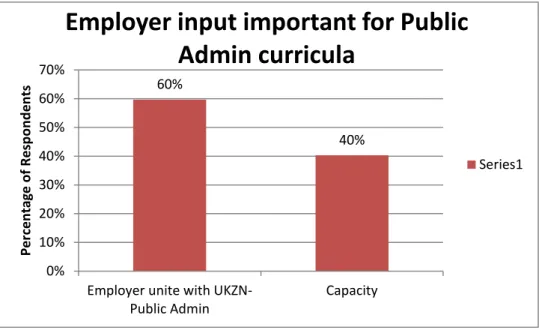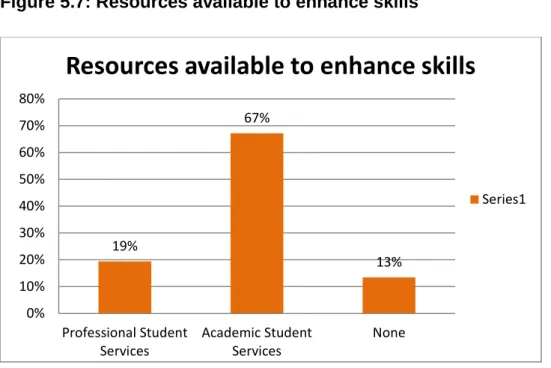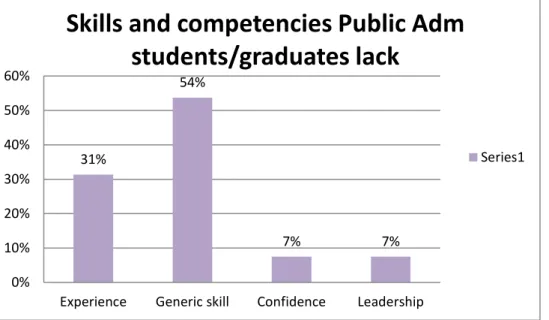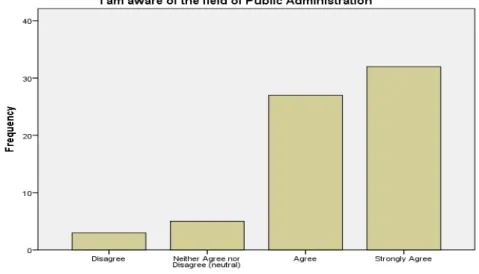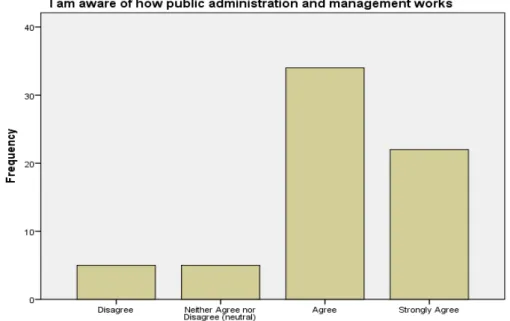The main objective of this study was to determine the extent to which graduates produced at the University of KwaZulu-Natal (UKZN) in the Discipline of Public Administration are sufficiently skilled and meet employer requirements. The study also recommends that sufficient resources are needed to achieve the skills development of students/graduates in the Public Administration program.
INTRODUCTION
BACKGROUND AND OUTLINE OF THE RESEARCH PROBLEM
Although the concept of capacity building is an issue in the South African civil service, it is important that graduates in the field of Public Administration are competent enough to become professional civil servants. According to the Graduate Opinion Survey 2014 conducted in the UKZN School of Management, IT and Management regarding the overall quality of the degree, 86% of graduate respondents were satisfied.
PRELIMINARY LITERATURE REVIEW
It is important that the education sector is continuously monitored to ensure that students are well equipped to enter the workforce (Pauw, Bhorat, Goga, Ncube and van der Westhuizen, 2006: 31). Therefore, it can be inferred that a monitoring and evaluation process is essential to ensure that the institutions produce graduates who meet the needs of those in the labor market.
BROAD PROBLEMS AND ISSUES TO BE INVESTIGATED
THE OBJECTIVES OF THE STUDY
KEY RESEARCH QUESTIONS
In the latter, it is based on legitimate authority within the bureaucratic structure of the organization. What skills do Public Administration graduates need to meet the demands of the public sector.
THEORETICAL FRAMEWORK
Batho Pele Principles
Consultation is about communication between public servants and citizens, therefore citizens should be consulted about the level and quality of public services they receive. Access does not only mean that the services are there, but also refers to the fact that they must be user-friendly; the attitude of service providers should be open and respectful.
PUBLIC MANAGEMENT
Public Management Model
PUBLIC ADMINISTRATION PARADIGM
Public Administration
RESEARCH METHODOLOGY
- Research Design
- Quantitative Method
- Qualitative Method
- Population
- Sampling
The term population refers to all the elements such as individuals, objects, events or substances that meet the sampling criteria for inclusion in the study (Burn and Grove 2005: 746). According to Babbie, random sampling is when each individual in the population has an equal probability of being selected, students in the Discipline of Public Administration.
DATA COLLECTION PROCEDURE
Stratified sampling means that specific characteristics of individuals (male and female) are represented in the sample and that the sample reflects the true proportion in the population of individuals with certain characteristics (Fowler). According to Babbie states that, in a multi-stage or clustering procedure, the researcher first identifies clusters (groups or organizations), obtains the names of individuals within those clusters, and then samples within them.
DATA ANALYSIS
Validity
Reliability
ETHICAL CONSIDERATION
Confidentiality
Informed Consent
STRUCTURE OF THE DISSERTATION
In this chapter, the researcher will draw conclusions from the data that was collected from the questionnaires and interviews. In this chapter, the researcher will try to examine the findings, suggest recommendations and draw conclusions.
CONCLUSION
In this study, the researcher focuses on the employability of graduates within the Public Administration program. It is important to prove that the public administration gives direction to the administrative behavior of public servants, to ensure the effective implementation of policies by the public service.
THE CONCEPT OF PUBLIC ADMINISTRATION
Essentially, one could say that it is important that public administration graduates at UKZN acquire the necessary qualities to ensure that they are employable. Therefore, one can conclude that, in order for public administration to be effective and efficient, persons who provide public services to the citizens must be competent to perform such duties.
DISTINCTIVENESS OF PUBLIC ADMINISTRATION
Schwella, Burger, Fox and Muller, cited in the Dayaram case, argue that public administration is this system of structures and processes; operates within a particular society as environment for the purpose of facilitating the formulation of appropriate, legal and legitimate governmental policies.
DISTINCTIVE CHARACTERISTICS
Immediate Environment
The public administrator's skill in program management ensures that the activities of the organization are carried out in an efficient and successful manner. Mullins claims that management is an integral part and foundation of the successful operation of an organization.
ADMINISTRATIVE AND MANAGERIAL PROCESSES IN PUBLIC
- Policy Making
- Organising
- Controlling
- Staffing
- Leading
Organizational or organizational arrangements relate to the establishment of hierarchies of officials and offices. Lynch agrees and states that leadership is the art or process of influencing people so that they strive willingly and enthusiastically towards the achievement of the organization's goal.
PUBLIC MANAGEMENT
- Public Management Model
- Cultural environment as part of general environment
- Suppliers
- Skills
- Applications
In the Discipline of Public Governance at UKZN, personnel management is termed human capital and policies have been developed in line with the national human resource management policies and guidelines and mandates issued by the Department of Public Service and Administration. The public administration model as depicted in Figure 1.2 explains and simplifies the complex concept of public administration and public resource management.
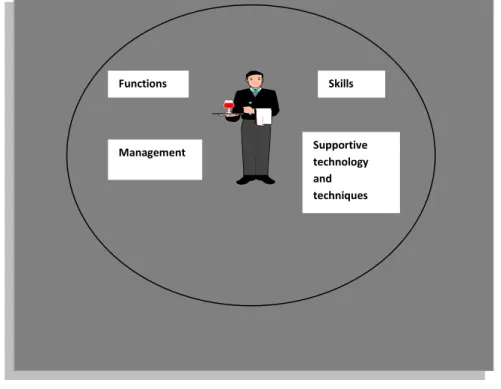
VALUES APPROACH TO PUBLIC ADMINISTRATION
Erasmus, Swanepoel, Schenk, van der Westhuizen and Wessels state that a civil servant is under an unqualified obligation to understand and appreciate these values and to make a conscious effort to ensure that his/her daily activities are guided by them. Therefore, this serves as an authoritative sign for the ethical performance of his/her duties.
IMPACT OF PUBLIC ADMINISTRATION ON SOCIAL SERVICE
HUMAN CAPITAL THEORY
Similarly, for Dimou and Shepard (2005: 6) Human Capital represents the knowledge and skills that individuals bring to the organization. Currently, it is accepted that the conceptual foundation of one's human capital is based on "something akin to knowledge and skills" acquired through an individual's learning activities.
LEGISLATIVE FRAMEWORK
Constitution of Republic of South Africa of 1996
The needs of the peoples must be responded to and the public encouraged to participate in policy making; To maximize human potential, good practices in human resources management and career development must be cultivated; And.
White Paper on Transformation of the Public Service of 1995
Public administration must be broadly representative of the South African people, with employment and personnel management based on ability, objectivity, fairness and the need to redress past imbalances in order to achieve broad representation (Constitution of the Republic of South Africa.
Batho Pele Principles
SKILLS DEVELOPMENT ACT 97 OF 1998
1998 should provide an institutional framework for devising and implementing national, sectoral and workplace strategies; developing and improving the skills of the South African workforce; to integrate these strategies within the National Qualifications Framework as envisaged in the South African Qualifications Authority Act, 1995; to provide apprenticeships leading to recognized professional qualifications; to provide for the financing of skills development through a levy financing scheme and a National Skills Fund; providing and regulating labor services; and to provide for matters relating thereto.
EMPLOYABILITY
Background of Employability
INSTITUTIONAL CHALLENGE
It is also necessary to ensure that the graduates produced have sufficient capacity and are employable. Therefore, it can be concluded that a monitoring and evaluation process is essential to ensure that the institution produces graduates that meet the needs of those in the labor market.
DEVELOPMENT OF EMPLOYABILITY AND PUBLIC
An initiative by the South African government through the former Minister of Public Service and Administration, Lindiwe Sisulu, led to the launch of the National School of Government and also a key stakeholder in promoting employability, which aims to attract new recruits train and develop and reorient and educate all civil servants currently employed (Mbanjwa, 2013: 81). Essentially, one can say that the National School of Government offers graduates the opportunity to gain the necessary experience and ensure that graduates are sufficiently equipped to survive in the work environment as future employees/civil servants.
EMPLOYABILITY AND PUBLIC ADMINISTRATION
- Degree subject knowledge
- Generic skills
- Emotional intelligence
- Career development learning
- Career Guidance
- Experience – work and life
- Reflection and evaluation
- Self-efficacy/self-confidence/self-esteem
As with all components in the model, the graduate will need to have well-developed emotional intelligence competencies in order to reach their true employability potential. It suggests that improving emotional intelligence is a desirable outcome for students, employees and employers, who argue that the key to employability as teachers is that students graduate with a solid foundation in the knowledge and skills they will need to be productive managers and effective leaders. .
VALUE OF THE EMPLOYABILITY MODEL
One might conclude that boosting self-esteem is a major part of the key to employability. Steinem in Pool and Sewell state that, “self-esteem is not everything; only that there is nothing without it.”
CONCLUSION
The purpose of this chapter is to present an overview of the conceptual framework of graduate employability. Therefore, the actions that managers take can have an impact on the performance of the organization.
DEFINITION OF EMPLOYABILITY
The focus is on defining employability, understanding how employability is formed and maintained, the relationship between tertiary institution, student and employer, organizational change, leadership and research undertaken in administrative management. It can be concluded that employability represents a web of understanding and complexity of the ever-changing environment in universities and shaping students/graduates to meet employer demands.
FORMATION OF EMPLOYABILITY
Garrido argues that their employability improves as people improve their skills, gain experience and become more competitive job candidates. Even if their position in the labor market never changes, their employability may have increased.
RELATIONSHIP BETWEEN TERTIARY INSTITUTIONS, EMPLOYER
ORGANISATIONAL CHANGE
Theories of organizational change focus on environmental conditions that create inertial pressure for organizational change. Essentially, organizational change plays a critical role in establishing and developing employability skills for graduates and in shaping future leaders in South Africa.
LEADERSHIP
Leadership Styles
Democratic: In this leadership style, power is concentrated more in the group than as a whole and the leader is more part of the team. Laissez-faire: Mullins argues that an authentic laissez-faire style is one where the leader observes that group members are doing well on their own and makes a conscious decision to transfer the focus of power to the members and not interfere, but is immediately available if help is needed.
Transformational Leadership
Leadership functions are shared with group members and they have a greater voice in decision-making and implementation of systems and procedures. Coles (in Matshabaphala 2008: 6) states that organizational cultures reflect the personalities and beliefs of the organization's leadership.
Leadership for Change
ADMINISTRATIVE MANAGEMENT
Unity of direction, managers should coordinate the efforts of employees working in facilities, but only one manager should be responsible for the behavior of an employee;. Initiative, the subordinate should be given the freedom to formulate and implement their own plans; and.
CONCLUSION
Barnard emphasizes the organization's dependence on investors, suppliers, customers and other external interests. According to Bless and Higson-Smith, scientific research is the translation into practice of the relationship between facts and theory presented to obtain specific information.
OBJECTIVES OF THE STUDY
Leedy in Brynard and Hanekom (2006: 2) agrees with Bless and Higson-Smith and says that research is essentially a thinking process, around accumulated facts and data, which attempts to determine what the facts say and what the data mean. The research is useful as it can improve effective service delivery, productivity, staff motivation and graduate satisfaction through improved leadership, performance management, entrenched values and adaptation to the best type of organizational culture model.
KEY QUESTIONS TO BE ANSWERED IN THE RESEARCH
VALUE OF ACTION-ORIENTATED RESEARCH
RESEARCH APPROACH
Creswell (2009: 3) suggests that quantitative methods are used to test the purpose of the theories by examining the relationship between other variables. Furthermore, qualitative methods are used in Creswell for individuals or groups that are attributed to a social or human problem.
SAMPLING PROCEDURE
Non-probability sampling
According to Fox and Bayat, non-probability sampling is a sampling technique where the probability that each element of the population is included in the sample is unknown. On the other hand, Denscombe argues that with non-probability sampling, there is a departure from the principle underlying probability sampling: that every member of the research population has an equal chance of being included in the sample.
Probability sampling
Stratified random sampling
DESCRIPTION OF TARGET POPULATION
For this study, the sample size was 105, 80 respondents who were final year students in the School of Public Administration at UKZN, 8 academic staff in public administration, 2 student advisors, 10 new hires and 5 employers (officials from the Prime Minister's Office). This sample size is derived from the opinions of final year students and freshers relating to the public administration program and understanding of the employability of UKZN graduates within the program in ensuring that the graduate is formed and meets employer expectations.
DATA COLLECTION PROCEDURE
- Data collection using personal interviews
- Data collection using questionnaires
- Construction of the questionnaire
- Questionnaire as the chosen method
The flow and length of the questionnaire should stimulate and sustain the reader's interest. Response set, which is the tendency of respondents to answer all questions in a specific direction, regardless of the content of the questions, should be avoided.
DESIGN OF THE QUESTIONNAIRE
The respondent may not have received the questionnaire from his manager at the local office.
DESCRIPTION OF THE QUESTIONNAIRE
DATA ANALYSIS
Validity
Reliability
ETHICAL CONSIDERATIONS
Confidentiality
Informed consent
CONCLUSION
83 percent of participants also agreed that they know how public administration works. A total of 71.1 percent of participants agreed that a degree in public administration can significantly improve job prospects.
ADOPTED METHODOLOGY
Quantitative data from completed questionnaires were coded and captured in SPSS (Statistical Package for Social Science) Version 20, for Windows and used for descriptive and inferential analysis, while the qualitative component was analyzed manually by grouping questions into thematic areas. The interpretation of the statistical analysis of the collected data shows the extent to which the research objectives and answers to the research questions have been met.
RELIABILITY ANALYSIS
The graph above shows that only 40.9 percent of respondents are male and 59.1 percent are female. The graph above shows that 4.5 percent of the respondents disagree and are not aware of the field of Public Administration, 7.5 percent are neutral, 40.3 percent agree and 47.8 percent are very much agrees.
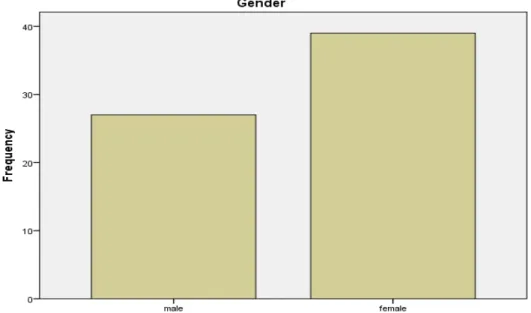
PRESENTATION OF QUALITATIVE FINDINGS
- Graduate meet requirement of employability
- Understanding Public Administration and its role in the Public Sector
- Graduate employability development
- Type of resources needed to develop skills
- Convert work learnt into working environment
- Graduate skills and competencies
- Expectations of Employer
- Integrated learning
- Skills, knowledge and understanding gained in public administration
- Graduates self-sufficient to execute a job search plan
One can conclude that there is a significant connection between the public administration and the public sector. Communication and writing skills need to be developed, which are key issues within the program as an English module is not incorporated into public administration curricula.
Evaluating the perception of students and graduates regarding
Assessing the employability of UKZN graduates
Assessing enterprising capacity of students and graduates
Evaluating the resourcefulness of students and graduates
CONCLUSION
The quantitative results show that the Department of Public Administration at UKZN has not established formal relations with public sector employers to ensure that the products emerging from HEIs meet the needs of the economy. In this regard, it is critical that the Department introduces measures that can focus on developing relations with employers in the public sector and improving skills development that will ensure capable and competent graduates in the public service profession.
- OBJECTIVES OF THE STUDY
- KEY RESEARCH QUESTIONS
- SUMMARY OF CHAPTERS
- CONCLUSION
- RECOMMENDATIONS
- CONCLUSION
Chapter two provided insight into the conceptual and contextual framework of public administration in relation to employability in the Department of Public Administration. The involvement of public sector employers within the public administration curriculum is important to achieve the quality of graduates and world-class services.
